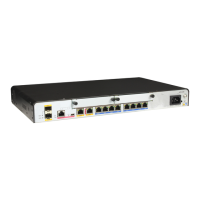NOTE
The configured MPLS MTU takes effect immediately and there is no need to restart the interface.
----End
2.5.7 (Optional) Configuring LDP MTU Signaling
LDP MTU signaling can be configured to control which MTU TLV to be sent.
Context
An MPLS LDP-enabled LSR by default sends a Huawei proprietary MTU TLV different from
the MTU TLV defined in RFC 3988.
l Using the default MTU setting is recommended.
l Before a Huawei device is interconnected to a non-Huawei device, run the mtu-signalling
apply-tlv command on the Huawei device. This command allows the Huawei device to
send the MTU TLV in compliance with RFC 3988 to the non-Huawei device. If this
command is not run, a configured LDP MTU may fail to take effect.
Procedure
Step 1 Run:
system-view
The system view is displayed.
Step 2 Run:
mpls ldp
The MPLS-LDP view is displayed.
Step 3 Run:
mtu-signalling [ apply-tlv ]
The function to send an MTU TLV is enabled.
The system sends a Huawei proprietary MTU TLV by default.
NOTE
Enabling or disabling the function to send an MTU TLV leads the reestablishment of existing LDP sessions.
----End
2.5.8 (Optional) Configuring an LDP Split Horizon Policy
An LDP split horizon policy can be configured to prevent an LSR from distributing labels to a
specified downstream LDP peer.
Context
An LSR sends Label Mapping messages to both upstream and downstream LDP peers by default,
speeding up LDP LSP convergence. DSLAMs functioning as access devices on an MPLS
network have low performance. All LDP peers (DSLAMs) by default exchange labels with each
other to establish a large number of LSPs. As a result, the DSLAMs are heavily burdened. An
Huawei AR1200 Series Enterprise Routers
Configuration Guide - MPLS 2 MPLS LDP Configuration
Issue 01 (2011-12-30) Huawei Proprietary and Confidential
Copyright © Huawei Technologies Co., Ltd.
44

